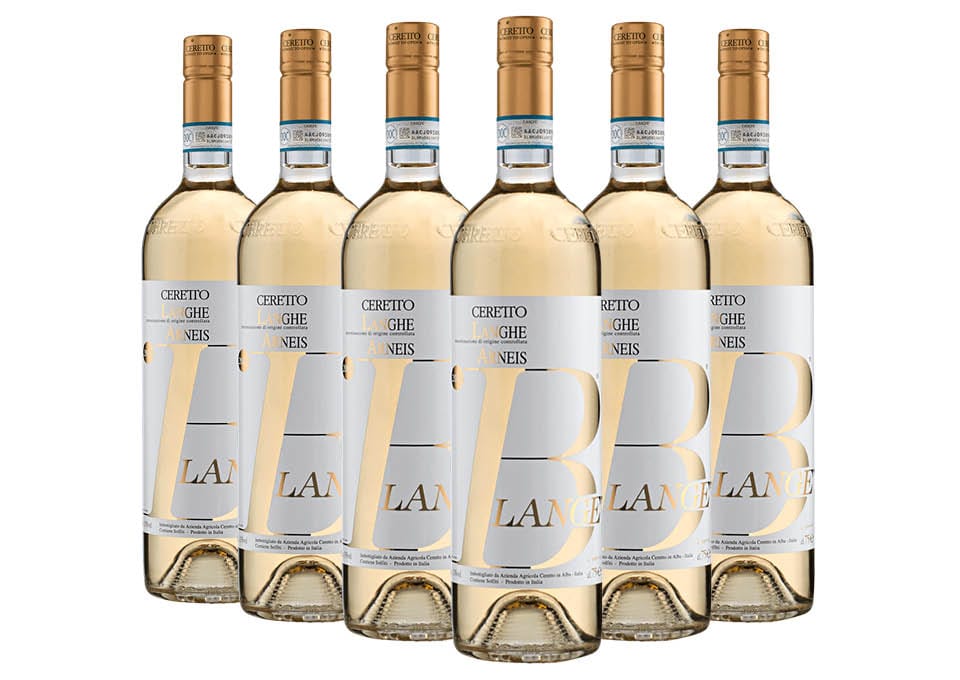Langhe, Arneis
Arneis is the native Piedmontese white grape variety symbol of Roero. Originally the Arneis grapes were used to soften the Nebbiolo grapes so as to define the wine obtained with them the 'Barolo Bianco'. In the 1970s only Vietti and Bruno Giacosa produced Arneis to the point that only the increase of interest in this variety in the following decades could lead to new plants. The Roero area extends on the left bank of the Tanaro river, right in front of the Langhe hills and the famous villages of Barolo and Barbaresco. In an area very suitable for viticulture, Arneis is quite vigorous, with good productivity and ripening expected by the end of September. Small productions of Arneis also appear in California, Oregon, New Zealand and Australia. The best examples of Arneis tend not to be aged in wood and are drunk within two years of bottling. The wine has a straw yellow color. The olfactory profile is intense and of great elegance, with aromas of flowers, white fruit and tropical nuances. On the palate it has a rich, full, soft, pleasantly fruity bouquet with moderate acidity. Some companies, in addition to still wines, produce sparkling versions, both with the Charmat method and with the Metodo Classico. Arneis is an excellent wine as an aperitif and goes very well with fish or vegetable appetizers, with cereal and vegetable soups, with seafood first courses and more generally with fish menus. Try the combination with tomini, grilled robiola or with a fresh cheese platter.
Why buy Arneis
If you are planning a disengaged aperitif or if you want to open the meal with a wine of great impact, buying Arneis can be the best and most advantageous solution. With its full and varied bouquet, Arneis is able to amaze at the first sip. Easy to appreciate, direct and very balanced, it can be considered a wine within everyone's reach, even for those who, as a non-connoisseur, want to appreciate the aromatic complexity of a wine without encountering excesses or surprises.
What are the best Arneis wines?
The best Arneis are undoubtedly those produced to be consumed very young with good fruit persistence and great aromatic intensity. Reference names in the production can be Malvirà, Bruno Giacosa, Sordo, Cascina Chicco.
Where is Arneis wine produced?
The traditionally most suitable area in which Arneis wine is produced is the Piedmontese one corresponding to Roero, that is the hilly area of the Province of Cuneo which borders the area of Alba and which includes municipalities such as Montà, Montaldo Roero, Vezza d'Alba.
What are the best combinations for Arneis wine?
For the best combinations to suggest compared to Arneis wine, the traditional Turin dishes are certainly the most suitable for enhancing its organoleptic characteristics. Among these, the Arneis-style rabbit, the Tajarin seasoned with butter and sage or white truffle, the raw meat of veal worked with a knife.
The Langhe, "land of wines, perfumes ... and novels" is masterfully described by the pen of the writer Beppe Fenoglio. It is a historical region of Piedmont comprising a vast territory of extraordinary beauty bordered by the Tanaro, Belbo, Bormida di Millesimo and Bormida di Spigno rivers, consisting of a succession of vineyards, hills, woods and a stone's throw from small ancient villages, which extends in many municipalities in the provinces of Cuneo and Asti. The Wine Landscapes offered by the Langhe-Roero hills became together with those of Monferrato a UNESCO World Heritage Site in 2014. It is impossible to visit the Langhe without stopping to admire examples of medieval architecture that dot the area such as the historic center of Alba or the Grinzane Cavour Castle, one of the most fascinating in the whole of Italy. The name derives from the local dialect, indicating the plural of a low and long hill.
The Langhe territory can be broken down into:
-
Bassa Langa, so called not for reasons of altitude, although it never exceeds 500 meters. It is the typical area of raw Albese meat and typical Piedmontese dishes based on butter and sage, wines and white truffles, for which a specially dedicated fair is held every year.
Alta Langa, an area on the border with Liguria, known for its woods and the hazelnut cake produced with the precious "tonda gentile delle Langhe" variety
Within its borders are some of the most famous DOCG wines in Italy, including Barolo, Barbaresco, Asti and Dogliani. Wines that do not comply with such stringent production criteria are welcomed in the Langhe DOC in which greater experimentation with varieties and enological techniques is granted. An emblematic case is that of the Langhe Chardonnay and other high quality wines, many of which are comparable to the prestigious Tuscan Super Tuscans.
The Production Regulations provides for different types: white, red, rosé, white and passito red. It is also possible to indicate the grape on the label for the varieties: arneis, chardonnay, favorita, riesling, nascetta, rossese bianco, sauvignon, nebbiolo, dolcetto, freisa, cabernet sauvignon, pinot noir, merlot, as long as the minimum percentage of the grape is used for the production of this wine is at least 85%.







